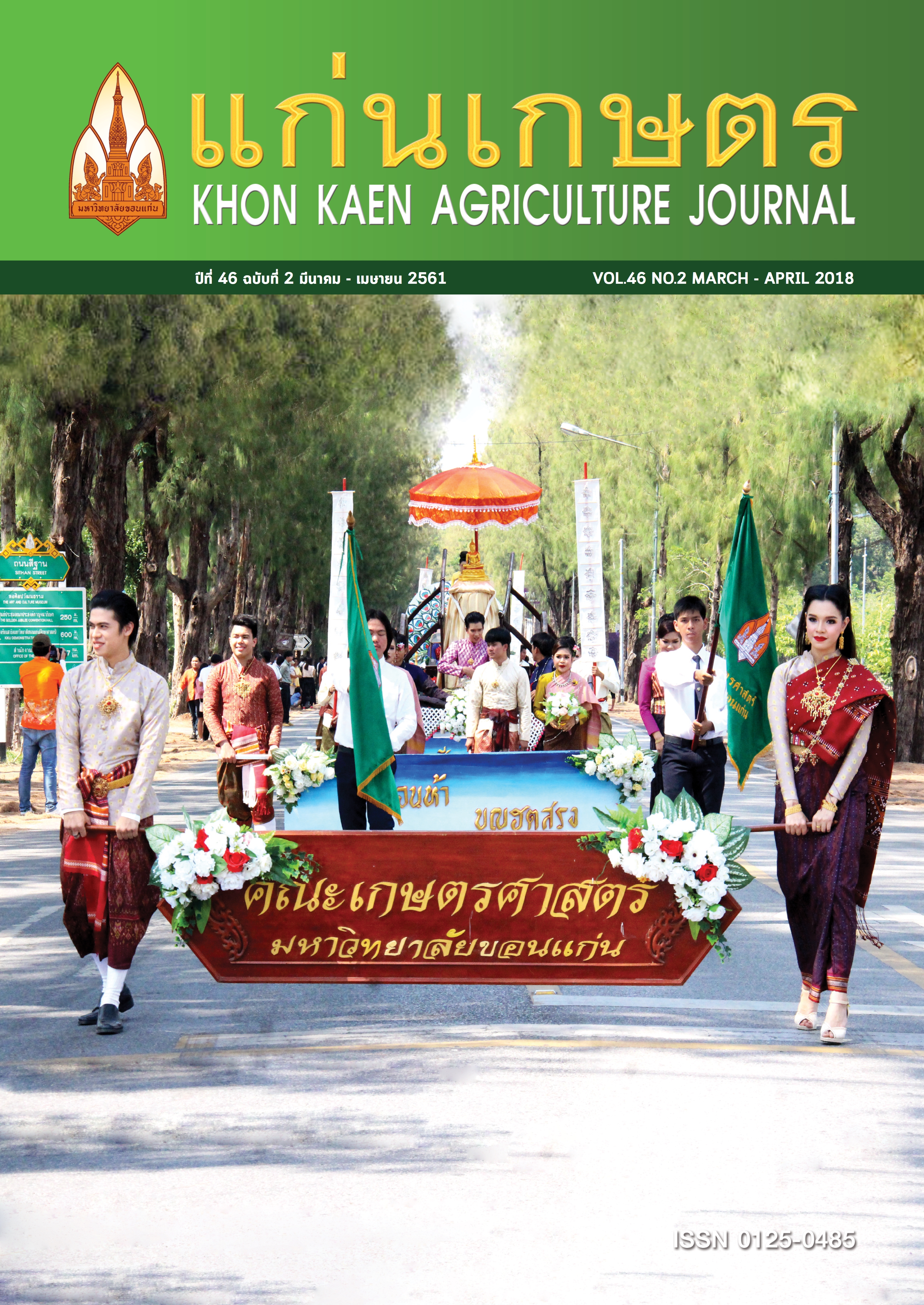ผลของกากแป้งมันสำปะหลังและถ่านแกลบชีวมวลต่อข้าวขาวดอกมะลิ 105 (KDML 105) ที่ปลูกในชุดดินร้อยเอ็ด
Main Article Content
บทคัดย่อ
การศึกษาผลของกากแป้งมันสำปะหลังและถ่านแกลบชีวมวลต่อข้าวขาวดอกมะลิ 105 (KDML105) ที่ปลูกในชุดดินร้อยเอ็ด แปลงเกษตรกรบ้านขี้เหล็ก ตำบลนาดี อำเภอนาเยีย จังหวัดอุบลราชธานี วางแผนการทดลองแบบ Randomized Complete Block (RCB) จำนวน 3 ซ้ำประกอบด้วย 10 ตำรับทดลอง ได้แก่ ไม่มีการใส่วัสดุปรับปรุงดิน (T1 และ T2) ใส่กากแป้ งมันสำปะหลัง (T3-T6) และใส่ถ่านแกลบชีวมวล (T7-T10) ทั้งสองวัสดุใส่ในช่วงการเตรียมดินในอัตรา 500, 1,000, 2,000 และ 4,000 กก./ไร่ตามลำดับ ในทุกตำรับทดลองใส่ปุ๋ ยเคมีในอัตราแนะนำตามค่าวิเคราะห์ดิน ยกเว้นตำรับ T2 ที่ใส่ในอัตรา 1.5 เท่าของอัตราแนะนำ ผลการศึกษา พบว่า การใส่กากแป้งมันสำปะหลังและถ่านแกลบชีวมวลมีผลต่อความสูงของต้นข้าว และน้ำหนักตอซังข้าว การใส่ถ่านแกลบชีวมวลในอัตรา 4,000 กก./ไร่ (T10) มีผลให้ความสูงของต้นข้าว และน้ำหนักตอซังข้าวสูงสุดอย่างมีนัยสำคัญทางสถิติ เท่ากับ 124 ซม. และ 568.3 กก./ไร่ตามลำดับ อย่างไรก็ตาม การใส่ถ่านแกลบชีวมวล มีผลให้ผลผลิตเมล็ดสูงกว่าการใส่กากแป้งมันสำปะหลัง และการไม่ใส่วัสดุปรับปรุงดิน แต่ไม่มีความแตกต่างกันทางสถิติ การใส่กากแป้ งมันสำปะหลังในอัตราต่าง ๆ มีผลให้ความเข้มข้นของธาตุไนโตรเจนในเมล็ดสูงกว่าอย่างมีนัยสำคัญทางสถิติ ส่วนการใส่ถ่านแกลบชีวมวลในอัตราต่าง ๆ มีผลให้ความเข้มข้นของฟอสฟอรัส และโพแทสเซียมในตอซังสูงกว่า ทั้งยังทำให้ปริมาณการดูดใช้โพแทสเซียม และแมกนีเซียมในเมล็ด และโพแทสเซียมในตอซังสูงกว่าอย่างมีนัยสำคัญทางสถิติ
Article Details
References
ธนาคารเพื่อการเกษตรและสหกรณ์การเกษตร. 2558. ถ่านชีวภาพ. แหล่งข้อมูล: https://goo.gl/DLnFVb. ค้นเมื่อ 6 กันยายน 2559.
ประเทศ สิทธิยศ, งามชื่น คงเสรี, เดชา ตุนา, สิริ สุวรรณเขตนิคม และแพรวพรรณ กุลนทีทิพย์. 2530. อิทธิพลของวันปลูกและปุ๋ ยเคมีที่มีต่อความหอมของข้าวขาวดอกมะลิ 105. ใน: ผลการวิจัยข้าวและธัญพืชเมืองหนาวประจำปี 2530. สถาบันวิจัยข้าว กรมวิชาการเกษตร กระทรวงเกษตรและสหกรณ์, กรุงเทพฯ.
สมศรี อรุณินท์. 2539. ดินเค็มในประเทศไทย. กรมพัฒนาที่ดิน กระทรวงเกษตรและสหกรณ์, กรุงเทพฯ.
สุกัญญา จัตตุพรพงษ์ และวราพันธุ์ จินตณวิชญ์. 2552. การใช้ประโยชน์เศษเหลือจากมันสำปะหลัง. ศูนย์ค้นคว้าและพัฒนาวิชาการอาหารสัตว์ สถาบันสุวรรณวาจกกสิกิจฯ มหาวิทยาลัยเกษตรศาสตร์, นครปฐม.
สุวิภาภรณ์ เจดรัม. 2557. การตอบสนองของข้าวหอมมะลิที่ปลูกบนดินที่ได้รับอิทธิพลของเกลือต่อวัสดุปรับปรุงดิน. วิทยานิพนธ์ปริญญาโท. มหาวิทยาลัยเกษตรศาสตร์, กรุงเทพฯ.
สำนักงานเศรษฐกิจการเกษตร. 2556. สถิติการเกษตรของประเทศไทยปี 2555. กระทรวงเกษตรและสหกรณ์, กรุงเทพฯ.
เสาวคนธ์ เหมวงษ์. 2556. ถ่านชีวภาพ: การกักเก็บคาร์บอน และความอุดมสมบูรณ์ของดิน. วารสารเกษตรพระจอมเกล้า. 31(1): 104-113.
เสาวคนธ์ เหมวงษ์. 2557. ผลของถ่านจากไม้ไผ่ และแกลบต่อผลผลิต และประสิทธิภาพการดูดใช้ไนโตรเจนของข้าวพันธุ์ชัยนาท 1. วารสารวิทยาศาสตร์และเทคโนโลยีมหาวิทยาลัยอุบลราชธานี.16 (1): 69-75.
Arunin, S. 1992. Strategies for utilizing salt-affected lands in Thailand. pp. 26-37. In: Proceedings of the International Symposium on Strategies for Utilizing Salt Affected Lands, February 17-19 1992, Bangkok, Thailand.
Bardsley, C.E., and J.D. Lancaster. 1965. Sulfur. pp. 1102-1166. In: C.A. Black, ed. Method of Soil Analysis, Part II: Chemical and Microbiological Properties. Amer. Soc. of Agron.Inc., Madison, Wisconsin.
Blackwell, P., G. Riethmuller, and M. Collins. 2009. Biochar Application to Soil. pp. 207-222. In: J. Lehman and S. Joseph, eds. Biochar for Environment Management. Science and Technology, UK.
Bray, R.A., and L.T. Kurtz. 1945. Determination of total organic and available forms of phosphorus in soil. Soil Sci. Soc. Am. J. 59: 39-45.
Chapman, H.D. 1965. Cation Exchange Capacity. pp. 891-901. In: C.A. Black, ed. Methods of Soil Analysis, Part 2: Chemical and Microbiological Properties. Agronomy, No. 9. Amer. Soc. of Agro. Inc., Madison, Wisconsin.
Day, P.R. 1965. Particle Fraction and Particle Size Analysis. pp. 545-567. In: C.A. Black, ed. Methods of Soil Analysis, Vol. 9. American Society Agronomy, Madison, Wisconsin.
Horsfall, M. Jnr, A.A. Abia and A.I. Spiff. 2003. Removal of Cu (II) and Zn (II) ions from wastewater by cassava (Manihot esculenta Cranz) waste biomass. African J. Biotech. 2(10): 360-364.
Jackson, M.L. 1965. Soil Chemical Analysis-Advanced Course. Department of Soils, University of Wisconsin, Wisconsin.Johnson, C.M., and A. Ulrich. 1959. Analytical methods for use in plant analysis. Calif. Agri. Exp. Stat. Bull. 767: 25-78.
Kilmer, V.J., and L.T. Alexander. 1949. Method of making mechanical analysis of soil. Soil Sci. Soc. Am. J. 68: 15-24.
Lehmann, J., J.P. Silva, C. Steiner, T. Nehls, W. Zech, and B. Glaser. 2003. Nutrient availability and leaching in an archaeological Anthrosol and a Ferralsol of the Central Amazon basin: fertilizer, manure and charcoal amendment. Plant and Soil. 249: 343-357.
Lindsay, W.L. and W.A. Norvell. 1978. Development of DTPA soil test for zinc, iron, manganese and copper. Soil Sci. Soc. Am. J. 42: 421-4.
Milla, O.V. and W.J. Huang. 2010. Effects of Rice Husk Biochar Produced under Slow Pyrolysis on Growth of Water Spinach (Ipomoea aquatic). National Pingtung University of Science and Technology, Taiwan.
Murphy, J., and J.P. Riley. 1962. A modified single solution method for determination of phosphate in natural waters. Anal.Chim. Acta. 27: 31-36.
National Soil Survey Center. 1996. Soil survey laboratory methods manual. Soil Survey Investigation Report No. 42, Version 3.0, Natural Conservation Service, USDA, Wisconsin.
Peech, M. 1945. Determination of exchangeable cation and exchange capacity of soils-rapid micromethods utilizing centrifuge and spectrophotometer. Soil Sci. 59: 25-38.
Pratt, P.E. 1965. Potassium. pp. 1023-1031. In: C.A. Black, ed. Method of Soil Analysis, Part II: Chemical and Microbiological Properties, Agronomy, No. 9. Amer. Soc. Agro. Inc., Madison, Wisconsin.
Prakongkep, N., R.J. Gilkes, W. Wiriyakitnateekul, A. Duangchan, and T. Darunsontaya. 2013. The Effects of Pyrolysis Conditions on the Chemical and Physical Properties of Rice Husk Biochar. Int. J. Material Sci. 3(3): 97-103.
Reisenauer, H.M., L.M. Walsh, and R.G. Hoeft. 1973. Testing Soil for Sulphur, Boron, Molybdenum, and chlorine. pp. 173-181. In: Soil Testing and Plant Analysis. Soil Science Society of America, Inc., Madison, Wisconsin.
Richards, L.M. 1954. Diagnostic and Improvement of Saline Alkali in Soil. U.S. Salinity Laboratory Staff, Dept. Agric., Washington D.C.
Soil Survey Division Staff. 1993. Soil Survey Manual. US. Dep. Agr.Handbook No. 18, U.S. Government Printing Office, Washington D.C.
Thomas, G.W. 1982. Exchangeable cation. pp. 159-166. In: A.L. Page, ed. Method of Soil Analysis. 2nd Edition. Amer. Soc. Agron. Inc., Madison, Wisconsin.
US Salinity Laboratory Staff. 1954. Diagnosis and Improvement of Saline and Alkali Soils. US Department of Agriculture, Washington, D.C.
Walkley, A. and C.A. Black. 1934. Anexamination of Degtjareff Method for determining soil organic matter: a proposed modification of the chromic acid titration method. Soil Sci. Soc. Am. J. 37: 29-35.
Weil, R.R., and N.C. Brady. 2017. Nature and Properties of Soils. 15th ed. Pearson Education. Inc., New Jersey.
Westerman, R.L. 1990. Soil Testing and Plant Analysis. 3nd ed. Amer. Soc. Agron. Soil Sci. Soc. Amer., Madison, Wisconsin.
Williams, N.A., N.D. Morse and J.F. Buckman. 1972. Burning vs incorporation of rice crop residues. Agron. J. 64: 467-468.

